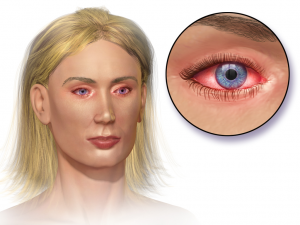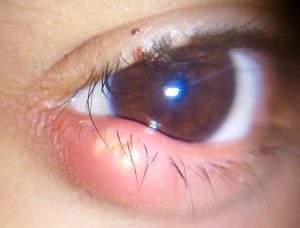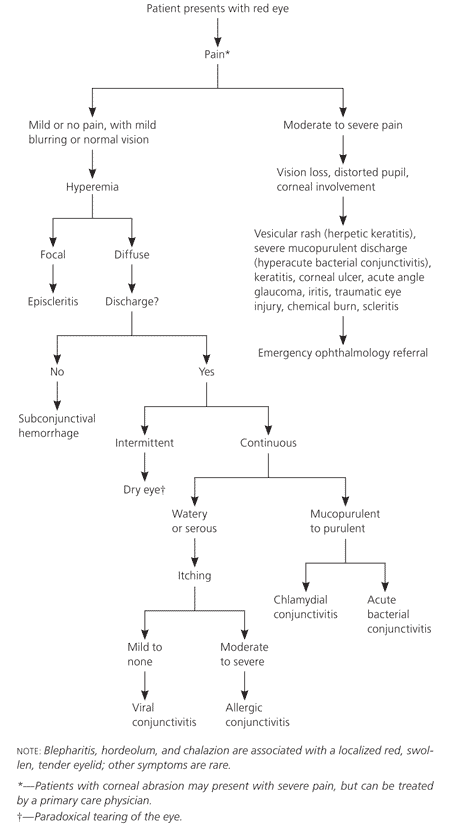
Management of Red Eye
Conjunctivitis, “red eye,” or “pink eye,” is a term used to describe any inflammation of the eyes, and can be caused by a multitude of problems. These can range from simple allergies due to some foreign irritants, to sight threatening infections and disorders. So…when should you come in to see Dr. Q @ QT Optometry for your red eye?

Allergic Conjunctivitis
This is an eye inflammation (non-infectious) that’s caused by the body’s allergic response to a foreign substances, such as pollen, dust, or mold spores. This type of reaction usually occurs around hay fever season, but can inflict at any time during the year. Other types of allergic conjunctivitis includes:
- Simple allergic conjunctivitis
- Seasonal/perennial conjunctivitis
- Vernal conjunctivitis
- Atopic keratoconjunctivitis
- Giant papillary conjunctivitis
Bacterial Conjunctivitis
The eyes have many wonderful mechanisms to resist bacterial infections (eye’s tears and other natural defenses), eye infection can still occur, especially when the invading bacteria is able to overcome the body’s resistance/defense mechanisms. Some common bacteria/pathogens that can lead to eye infection are:
- Staphylococcus
- Haemophilus
- Streptococcus pneumoniae
- Moraxella
- *Streptococcus and Haemophilus, tend to occur more commonly in children*
Viral Conjunctivitis
A wide range of viruses can lead to some form of conjunctivitis. Most of these conjunctival infections, however, are somewhat mild, transient, and very self-limiting. Although, there are some viral infections that may lead to significant symptoms and/or visual outcomes. The most common viruses associated with conjunctivitis are:
- Adenoviral Conjunctivitis – currently more than 47 different serotypes of the adenovirus and is highly contagious
- Herpetic Conjunctivitis – member of the herpes simplex, varicella-zoster, or Epstein-Barr virus
Other Causes of Conjunctivitis
Contact Lens-Related Conjunctivitis:
- Prolonged contact lens wear may cause secondary conjunctivitis conditions. Once that occurs, complications can either be acute, chronic, allergic, or nonallergic in origin.
Mechanical Conjunctivitis:
- Common causes of conjunctivitis secondary to mechanical irritation may be caused by entropion, trichiasis, sutures, and/or foreign bodies.
Other Causes of Conjunctivitis
Traumatic Conjunctivitis:
- Direct injury, caused by lacerations, abrasions, or epithelial defects; or by indirect trauma, caused by chemical burns, may lead to the clinical manifestation of conjunctivitis.
Toxic Conjunctivitis:
- Toxic conjunctivitis may occur after being exposed to noxious chemicals and/or drugs.
Neonatal Conjunctivitis:
- Ophthalmia neonatorum usually occurs within the first months of a life. The introduction of silver nitrate prophylaxis in 1881 dramatically reduced the incidence of gonococcal neonatal conjunctivitis.
Secondary Conjunctivitis
Ocular and systemic conditions may be associated with a variety of conjunctivitis. These ocular and system disorders includes:
- Keratoconjunctivitis sicca
- Lyme disease
- Anterior blepharitis
- Meibomitis
- Superior limbic keratoconjunctivitis
- Reiter’s syndrome
- Cicatricial pemphigoid
- Floppy lid syndrome
- Erythema multiforme
- Mucous fishing syndrome (Stevens-Johnson syndrome)
- Collagen-vascular diseases
- Relapsing polychondritis
- Sarcoidosis




